WILLIAM KAPSARIS' RESEARCH
Amazing Little Epsilon!
. . . a scale-model pyramid that really works.
What were the wondrous thoughts that inspired the architects of the Great Pyramid of Cheops at El Giza, Egypt? Did clever
earthlings build the giant pyramid to win the favor of the Pharaoh? Or . . . was its construction the work of visitors from outer
space? Many curious explorers, scientists, and tourists have tried to solve the mystery. They've been braving the desert for
centuries to examine the ancient pyramid and search for clues.
One thing they had hoped to find was the mathematical ratio used in its design. In his book, Secrets of the Great Pyramid
(Harper & Row, 1971), Peter Tompkins points out that a number of surveyors measured the pyramid and tried to pinpoint the
ratio. It was a difficult task because most of the pyramid's outer masonry, including the peak, was missing. Heated debates
resulted, which narrowed down the field, for the most part, to two ratios. One was pi. (pi = 3.1416: the ratio of the
circumference of a circle to its diameter -- Webster) The other one, phi, was a ratio found in nature and praised by artists.
Leonardo da Vinci named it the Golden Section. (golden section, a ratio between two portions . . . in which the lessor of the
two is to the greater as the greater is to the sum of both: a ratio of approximately 0.6180 to 1.000 -- Random House)
That's a tough act to follow! I've never visited the Great Pyramid, and I wouldn't have known how to measure it if I had. So I
hesitate saying that its architects may have used another ratio. However, experiments with scale-models I've made of the Great
Pyramid have led me to consider one. It's a ratio close to phi that produced a very
special little pyramid I've named Epsilon.
Epsilon would be right at home in the desert. It puts on quite a show when the humidity is low -- 30 percent or less. For
instance, when the model is standing with its base line on magnetic North, the scent of the transparent tape that holds it together
accumulates inside it. Models built on the pi and phi ratios do not collect the scent, not even a trace.
Epsilon can also amplify the scent of the tape and send it into the air. I'll never forget the first time it did. That day, because the
humidity inside the house was low, I had taken a few minutes to check on Epsilon before dashing off to work. The little model
was on the dining room table where I had been experimenting with it. One whiff of its interior told me that it was doing an
excellent job of collecting the tape's scent. For lack of a better idea, I put an old wristwatch inside it on a stand one third the
model's height. (The watch was a gift I hadn't worn in years, because the luminous paint on its hands and face was emitting a
low level of radioactivity.) After I had realigned the model with magnetic North, I left for work. When I returned, about ten
hours later, the scent of the tape had filled every room in the house: the dining room, front room, and kitchen on the first floor,
and the two bedrooms and the bathroom on the second. Not knowing what to expect next, I moved Epsilon into the two-car
garage thirty feet behind the house and set up the experiment.
It took days to air out the house. The scent clung to the drapes, carpeting, and upholstered furniture. In the mean time, Epsilon
had filled the garage with the scent! Equally baffling, a few hours after I had placed a leaf from a tree next to the watch inside
Epsilon, the air in the garage picked up the strong aroma of foliage!
True, the watch played an important part in the experiments, but the primary factor was amazing little Epsilon. What is the
mathematical ratio of Epsilon's design? Computing it is easy -- just divide the height of one side by half its base length. See
Figure 1.
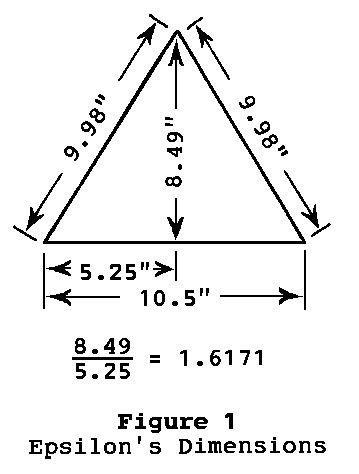
To compare Epsilon with models that have designs based on the pi and phi ratios, refer to Figures 2 and 3.
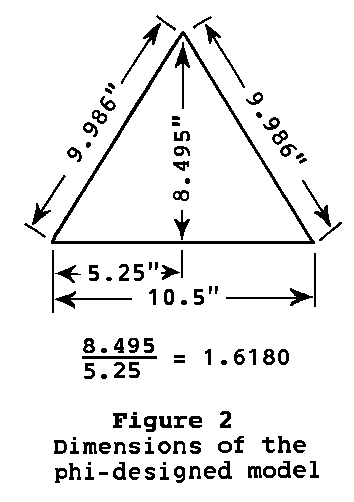
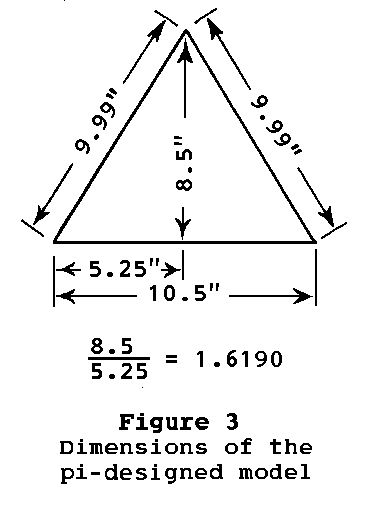
To build a scale-model like Epsilon: Scribe outlines of its four sides on illustration board with the point of a knife. Check the measurements for accuracy with a ruler graduated in hundredths of an inch. View the graduations with a 10X power magnifying glass. Use a straightedge as a guide, and cut out the sides with a knife. Start assembly by taping the inside edge of each ascending corner of the model, its full length, with 3/4-inch transparent tape. Then place the model on a flat surface, and tape the exterior edge of each corner, its full length. Note the illustration in Figure 4. A plan offered for the stand is in Figure 5.
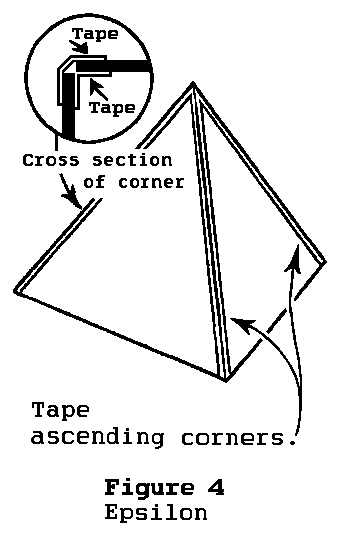
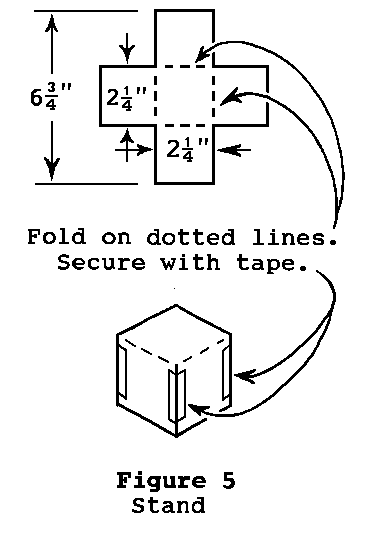
It may take several attempts to build a model that has little Epsilon's dimensions, but it'll be worth it. The most exciting and
convincing pyramid experiments of all are the ones performed firsthand. Speed up the process of building a model that "hits the
mark" by assembling several at a time. When the humidity is low, test them: align them with magnetic North, wait about an hour,
and then check the air inside them. Be on the lookout for a model that collects the scent of the tape holding it together. Use it to
duplicate the experiments described in this article or to venture into unknown territory. Perhaps
. . solve the mystery of the Great Pyramid of Cheops!
Please note: The author is not liable for anything that may happen because of the experiments and ideas presented in
this article. He, however, wishes the reader every success.
e-mail welcome: wmkap@sbcglobal.net
FREQUENTLY ASKED QUESTIONS
. . . including a simple focal point test.
HOW PRECISE DO EPSILON'S MEASUREMENTS HAVE TO BE?
The measurements are critical. Nevertheless, I've been getting good results just by taking the care a patient hobbyist would use when building a scale-model plane or train. With a keen eye and steady hand, one model out of three will "hit the mark," have the right focal point.
A model built on Epsilon's design ratio, 1.6171, will have an internal focal point. But a phi-designed model, with a 10.5 inch base, will have a focal point about 1 to 2 inches below its base. And a similar size model built on the pi ratio will have a focal point about 6 to 8 inches below its base.
TO FIND A MODEL PYRAMID'S FOCAL POINT:
Build a test pad made of layers of cotton or flannel clothing. Fold and stack the clothing in a pile with a top large enough to hold a model and about 10 inches deep (Best use disposable garments to build the test pad, for they may start to decay after a month or so of prolonged testing). When the humidity is relatively low, place an empty model on the test pad and align the bottom edge of a side of the model with magnetic north. Wait about 10 hours. Then check the air in the model. If the model collects the scent of the tape holding it together, its design is based on Epsilon's design ratio. If the tape scent collects an inch or two into the test pad, the model's design is based on the phi ratio. And if the tape scent penetrates 6 to 8 inches into the test pad, its design is based on the pi ratio.
WHERE CAN I FIND A RULER THAT MEASURES 100ths OF AN INCH?
Shops that sell equipment to tool-and-die-makers most likely have them. However, a few years ago I found a 12 inch ruler made by Starrett, Model Number CB12-16R, at a hardware store.
HOW DO YOU ALIGN THE MODEL WITH MAGNETIC NORTH?
With the aid of a compass, like the ones campers use, visually align the bottom edge of a side of the model with magnetic north.
ISN'T THE GREAT PYRAMID ALIGNED WITH TRUE NORTH?
Yes, it is. The Great Pyramid is aligned with true north to within 3' of a degree, and magnetic north at the Pyramid's location is approximately 2 deg's 38' east of true north.
WHERE DO YOU LIVE? WHAT IS YOUR LATITUDE AND LONGITUDE?
I live in Niles, Illinois (a suburb of Chicago, Illinois) in the USA, Lat: 42 deg's 01.5' N, Long: 87 deg's 48.2' W. Magnetic north at my location is approximately 2 deg's 10.5' west of true north.
IS THE WATCH NECESSARY?
It is. The low level of radioactivity produced by the luminous paint on the watch's hands and face seems to act as a catalyst to amplify and send into the air the scent of items placed inside Epsilon. Old watches suitable for this purpose can be found at resale shops.
DID YOU PATENT EPSILON?
No, It is in the public domain. Publishing the essay, "Amazing Little Epsilon," put it there.
HAS ANYONE BEEN ABLE TO BUILD AN EPSILON THAT WORKS?
Yes. For example, Walter Hedzik, a gentleman on the Epsilon e-mail List, writes: "I put an Epsilon together from the web site plans, the measurements were off a little, couldn't or didn't have access to a 100th increment ruler, but even though it was off there was for two days a tape smell in my garage. After two days nothing.
"All I know is that somethin' was goin' on. I shall try again after I locate a ruler."